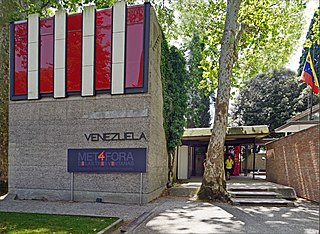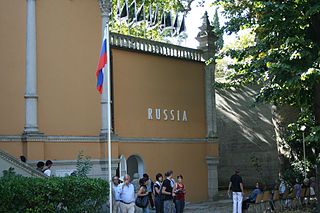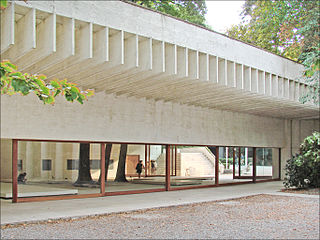
The Korean pavilion houses South Korea's national representation during the Venice Biennale arts festivals.

The Korean pavilion houses South Korea's national representation during the Venice Biennale arts festivals.
The Venice Biennale is an international art biennial exhibition held in Venice, Italy. Often described as "the Olympics of the art world", participation in the Biennale is a prestigious event for contemporary artists. The festival has become a constellation of shows: a central exhibition curated by that year's artistic director, national pavilions hosted by individual nations, and independent exhibitions throughout Venice. The Biennale parent organization also hosts regular festivals in other arts: architecture, dance, film, music, and theater. [1]
Outside of the central, international exhibition, individual nations produce their own shows, known as pavilions, as their national representation. Nations that own their pavilion buildings, such as the 30 housed on the Giardini, are responsible for their own upkeep and construction costs as well. Nations without dedicated buildings create pavilions in venues throughout the city. [1]
The Korean Pavilion, designed by Seok Chul Kim and Franco Mancuso, was built between 1994 and 1995. [2]
South Korea has participated in the Venice Biennale since 1995. [3]
This section needs additional citations for verification .(May 2019) |

The German pavilion houses Germany's national representation during the Venice Biennale arts festivals.

The Austrian pavilion is a national pavilion of the Venice Biennale. It houses Austria's official representation during the Biennale.

The French pavilion houses France's national representation during the Venice Biennale arts festivals.

The Swiss pavilion houses Switzerland's national representation during the Venice Biennale arts festivals.

The Australian pavilion houses Australia's national representation during the Venice Biennale arts festivals.

The Czech and Slovak pavilion houses the national representation of the Czech Republic and Slovakia during the Venice Biennale arts festivals.

The Belgian pavilion houses Belgium's national representation during the Venice Biennale arts festivals.

The Brazilian pavilion houses Brazil's national representation during the Venice Biennale arts festivals.

The Venezuelan pavilion houses Venezuela's national representation during the Venice Biennale arts festivals. It is located in the Giardini della Biennale.

The Uruguayan pavilion houses Uruguay's national representation during the Venice Biennale arts festivals.

The Serbian pavilion houses Serbia's national representation during the Venice Biennale arts festivals.

The Russian pavilion houses Russia's national representation during the Venice Biennale arts festivals.

The Polish pavilion houses Poland's national representation during the Venice Biennale arts festivals.

The Japanese pavilion houses Japan's national representation during the Venice Biennale arts festivals.

The Dutch pavilion houses the Netherlands's national representation during the Venice Biennale arts festivals.

The Hungarian pavilion houses Hungary's national representation during the Venice Biennale arts festivals.

The Israeli pavilion houses Israel's national representation during the Venice Biennale arts festivals. Jewish Israeli artists first participated in the 24th Venice Biennale in the Erez Israel, Artisti Palestinesi pavilion. Israel first participated in the 25th Venice Biennale in 1950.

The Finnish pavilion houses Finland's national representation during the Venice Biennale arts festivals.

The Nordic Pavilion houses the national representation of the Nordic countries Sweden, Norway, and Finland during the Venice Biennale arts festivals.
The Danish pavilion houses Denmark's national representation during the Venice Biennale arts festivals. The building was designed by Carl Brummer and constructed between 1930 and 1932, and restored and expanded by Peter Koch in the 1950s.